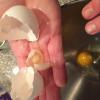Serendip is an independent site partnering with faculty at multiple colleges and universities around the world. Happy exploring!
You are here
Home » Web Paper or Special Event
By mpan1
October 22, 2016 - 00:09
A question that arose after reading Suzan- Lori Park’s “Getting Mother’s Body” was why was having nontraditional characters and characters who suffered loss necessary to the plot of the novel. There are elements of characters that many authors do not incorporate in their books such as untraditional sexualities and people with disabilities. In this novel, Dill Smiles is referred as a “bulldagger” according to Teddy (Parks 25). Most of the main characters, who are the Beedes, also have a reputation of being cursed with bad luck. As Star, Homer’s mother, describes them, “They will always be Beedes, which is to say they will always be grubbing in the dirt”(Parks 137). The curse can be seen throughout the family.
October 22, 2016 - 00:01
The art piece I selected is a Dan Tribe ceremonial spoon from West Africa. I felt compelled to research this art piece because I first saw it pictured on a card that I had taken from the front desk of Canaday Library. On the back of the card, there is a description of the spoon, which helped me locate it in the TriArte database. Although I was able to find the spoon in the catalog, I noticed that the description on the back of the card differs from the description on the database. The card tells us that it can be dated back to the late 19th century, but the database tells us that it is from the early 20th century. The card says that the spoon is from Liberia, but the database says that it is from Côte d’Ivoire.
October 21, 2016 - 22:46
Did Billy Beede follow the footsteps of her mother?
October 21, 2016 - 20:38
Gender in America in the 1960s could be wrapped neatly with a bow by the word rigid (cisnormative). The nation's consensus was that a person’s biological sex assignment as male or female at birth was the person's gender identity that was upheld throughout life. Masculine and feminine were the traditional structural identities that people were confined to. While prior to the Stonewall Riots transgender and queer people existed, their visibility was erased by police brutality, discrimination, and misrepresentation. In her novel, Getting Mother’s Body, Suzan-Lori Parks creates a character, Dill Smiles, whose gender identity is represented as ambiguous throughout the novel.
October 21, 2016 - 19:54
Vivian O’Bannon
Jody Cohen
Emily Balch Seminar: Changing Our Story
October 21, 2016
Gender: The Worst Trait to Inherit
October 21, 2016 - 17:35
By LiquidEcho
October 21, 2016 - 17:15
In the context of the relations between Dill and other characters, how is Dill’s identity represented and explored throughout the novel?
Exploring Identity without Labels
October 21, 2016 - 16:58
Suzan-Lori Parks takes on many controversial issues in her novel Getting Mother’s Body: abortion, race, socioeconomic status, homosexuality, and countless other topics are explored throughout the work. One of these important matters is that of gender roles. Two of the main characters in the novel, Billy Beede and her Aunt June, find their lives dictated by men, and share a common struggle to regain control of their respective paths. In Getting Mother’s Body, June’s arranged marriage and Billy’s unplanned pregnancy highlight men’s tendency to make decisions on behalf of women, acting dually as women’s initial downfall and ultimate savior.
October 21, 2016 - 16:56
The 1960’s were a time of change in American society. Due to the Civil Rights Movement, which was led by Doctor Martin Luther King Jr. and supported by President John F. Kennedy, society’s treatment of black Americans was changing for the better. This was a time of growing acceptance of the differences between us as individuals. However, many differences remained taboo - specifically, homosexuality and refusing to fit gender roles. In Suzan-Lori Parks’ novel, “Getting Mother’s Body,” the character Dill Smiles shows how these taboos were viewed by others at this moment in time. Dill, who is widely believed to be a hyper-masculine lesbian, endures a lot of hatred and scorn from others upon their realization that they are not a heterosexual man.
October 21, 2016 - 16:51
Some people receive their characteristics from genetics, but their identity could from other places. A person can develop their identity from their family, because usually they are the ones who influence their beliefs and values. Then their beliefs and values usually determine how they are as a person. Although there are people who do not want to be like the rest of their family, and try to diverge to create their own identity. Personally, I know some families where most of the members of the family all hold similar characteristics. In Susan-Lori Parks novel, Getting Mother’s Body, everyone in the town knows what it means to be a Beede, but the characters diverge from that stereotype.










